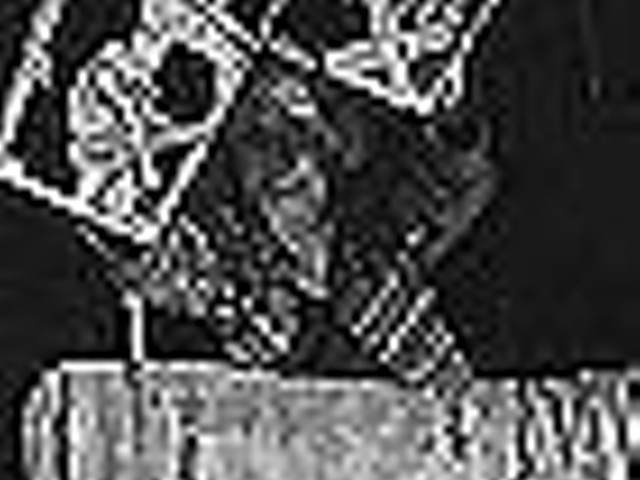It's an age-old story, at least in the age of underground. Boys and girls invent their own separate culture out of necessity, disenfranchisement and creative angst.
Boys and girls fill that world with passion, faith and loyalty. Their culture gets appropriated and infected by commercial interests, bum highs and participants who don't share the original passion which made the new community so special.
Boys and girls move their cultural touchstones just outside the grasp of the mainstream. The culture splinters and shatters into disparate worlds. Splinters live, die and propagate. Some boys and girls stick to it, some give up, some carry it to farther corners of the world to start over. It's happened before: Rock 'n' roll, flower power, punk. Now, it's happened with electronic music.
This is, of course a simplistic summary. If it's a comprehensive, fingers-in-the-grease account you seek, look no further than Generation Ecstasy, the new tome from been-here-all-along electronic music scribe Simon Reynolds.
The first third of the book is an in-the-trenches page-turner that welcomes novices to the wonderful world and languages of "sampladelia," techno, gabba house, jungle and rave. It's like a primer for those sitting on the edge, clinging to rock notions, beckoned forward by the siren song of the now-above-ground soundworld of electronic music (that which is geared for dancing and otherwise.)
The chapters on the genre's American roots convey the vibe of the adventurous, genre-crossing hothouse that epitomized '80s music.
Reynolds neatly summarizes the wide-eyed, technologically naive invention and notions of a brave new music, knowing full well that there's an entire book waiting to be written on the Detroit-Chicago-New York club world.
These histories are the rudimentary baby steps for those of us who are still listening to techno trying to find the middle eight, wondering when the chorus is going to kick in.
Reynolds' attempt to tell the techno twist on familiar cultural dynamics succeeds largely due to the personalities that shine through his narrative, and partly due to his of-it-not-above-it approach to the material. His awareness of the pop culture parallels and the very important, subtle political and economic differences between various underground musical movements over the past 40 years in both Britain and America is as informed and astute as his discussions of rave culture's players.
Perhaps an oral history would be more immediate and moving, but Reynolds strikes a balance, managing not to be overbearing, but also not uncritical.
As the electronic/dance/rave scene is still a drama unfolding, Reynolds strings together the seminal (in this case, Detroit, Chicago and New York's techno, house and garage, respectively), the second-generation appropriation (the early '90s British rave scene) and the ensuing, geographically specific versions of the present genre with an ease that keeps the proceedings grounded firmly in the here and now, as well as in the potential future.
Simply, he's drawing a map for a generation that already knows many of the stops along the road.
Generation Ecstasy is a tale of cultures and their inhabitants. Not that the music upon which the culture is based is secondary, but without a ridiculously comprehensive accompanying sound track and at least a rudimentary familiarity with electro-dance-non-rock musics, Generation Ecstasy is essentially a cultural soap opera.
And this is the true strength and value of it.
That assertion is painfully clear when Reynolds takes relatively feeble running starts at you-had-to-be-there descriptive ramblings about the music.
Much of the music and scenes he documents are created in the context of the participants' consumption of the drug Ecstasy. Ever tried to describe a drug trip to someone who's never taken anything stronger than Tylenol? Guess you had to be there. Elvis Costello was right and, for most of the book, Reynolds thankfully realizes that he can't dance about architecture.
When Reynolds takes off into the British underground that sprang up in the inevitable trans-Atlantic musical exchange, the narrative takes flight. His exploration of late '80s England morphing into the premillennial stewpot that has just now popped into the American mainstream is astute and thorough.
Better still, Reynolds charts the rise of MDMA (Ecstasy) through the scenes on both continents, and does an admirable job conjuring the loved-up "all together now" vibe that the drug, at least initially, cast upon them. The Ecstasy-fueled awakening to the best aspects of the Flower Power generation lifted the scene's youthful optimism from a trip of its own to a growing, nearly New Age cosmic awareness.
But Reynolds also documents with equal compassion and acumen the predictable pattern: As word got around of the profits, easy fun, self-discovery and safe decadence to be had with Ecstasy, the scene dissolved into shitty drug knockoffs, bad trips, legal persecution and a redoubled effort by movers and shakers to take the music and culture back underground. And the cycle continued.
Reynolds is neither preachy nor uncritical, which saves Generation Ecstasy from becoming an elaborate love letter to good times gone by.
Between the covers of this book is a story far too ephemeral and complex to be easily told. To his credit, Reynolds' run at it is an inspirational start for those who don't know, a clear-eyed reminiscence for those who do, and a necessary beginning to a story of a generation that, until now, has stuck with the old, "if you have to ask ..." code.





